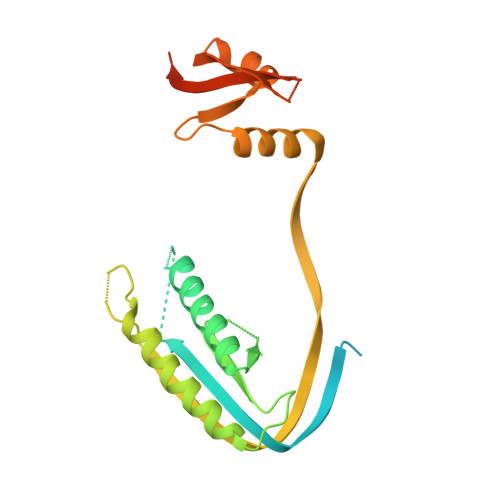New structural forms of a mycobacterial adenylyl cyclase Rv1625c.
Barathy, D., Mattoo, R., Visweswariah, S., Suguna, K.(2014) IUCrJ 1: 338-348
- PubMed: 25295175
- DOI: https://doi.org/10.1107/S2052252514016741
- Primary Citation of Related Structures:
4P2F, 4P2M, 4P2X - PubMed Abstract:
Rv1625c is one of 16 adenylyl cyclases encoded in the genome of Mycobacterium tuberculosis. In solution Rv1625c exists predominantly as a monomer, with a small amount of dimer. It has been shown previously that the monomer is active and the dimeric fraction is inactive. Both fractions of wild-type Rv1625c crystallized as head-to-head inactive domain-swapped dimers as opposed to the head-to-tail dimer seen in other functional adenylyl cyclases. About half of the molecule is involved in extensive domain swapping. The strain created by a serine residue located on a hinge loop and the crystallization condition might have led to this unusual domain swapping. The inactivity of the dimeric form of Rv1625c could be explained by the absence of the required catalytic site in the swapped dimer. A single mutant of the enzyme was also generated by changing a phenylalanine predicted to occur at the functional dimer interface to an arginine. This single mutant exists as a dimer in solution but crystallized as a monomer. Analysis of the structure showed that a salt bridge formed between a glutamate residue in the N-terminal segment and the mutated arginine residue hinders dimer formation by pulling the N-terminal region towards the dimer interface. Both structures reported here show a change in the dimerization-arm region which is involved in formation of the functional dimer. It is concluded that the dimerization arm along with other structural elements such as the N-terminal region and certain loops are vital for determining the oligomeric nature of the enzyme, which in turn dictates its activity.
Organizational Affiliation:
Molecular Biophysics Unit, Indian Institute of Science , C. V. Raman Avenue, Bangalore, Karnataka 560 012, India.


















